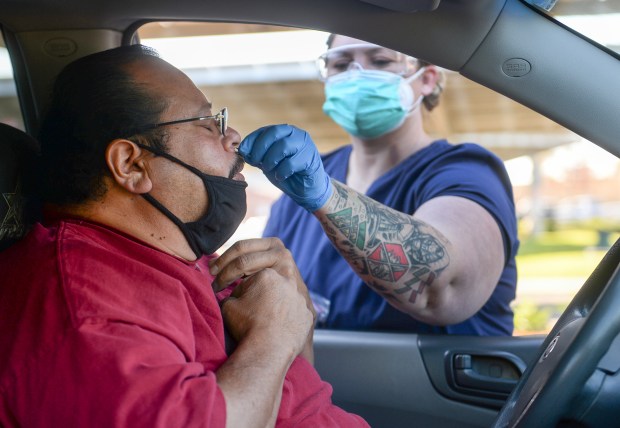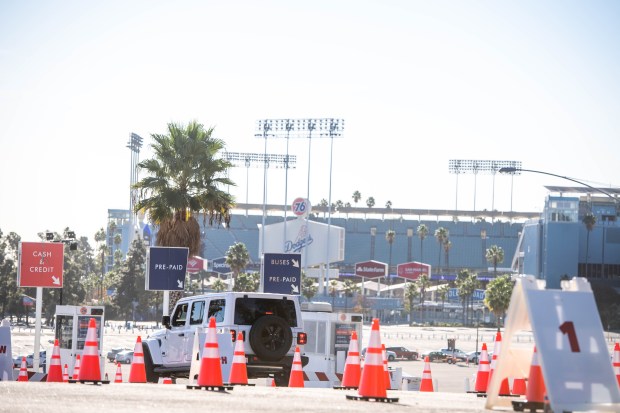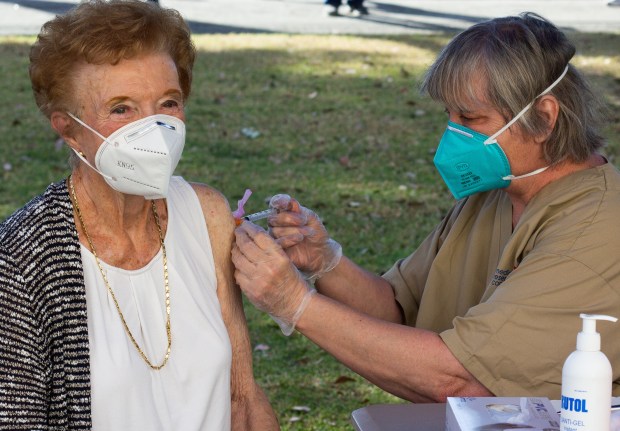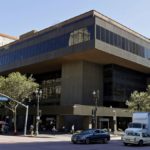
Public Health officials on Saturday, Jan. 16 confirmed the faster-spreading UK variant of COVID-19 has reached Los Angeles.
An infected person, only described as “male,” recently “spent time” in Los Angeles County before traveling to Oregon, where he is currently isolated. The variant was confirmed by Quest Laboratories in Washington state. No other information on where the man was in the LA area was immediately available.
Although it is the first confirmed case of the variant in Los Angeles County, public health officials here believe that the new, more contagious strain is already spreading in the community, and are continuing to test samples.
The variant, first discovered in the United Kingdom, previously was reported in San Diego and San Bernardino counties.
The variant is likely to become the dominant strain in the United States by March, the Centers for Disease Control and Prevention (CDC) said in a new report Friday. The mutation is considered more contagious and is expected to spread rapidly early this year.
Los Angeles health officials also said Saturday that the county has surpassed one million confirmed COVID-19 infections – with a total of 1,003,923 cases.
Officials reported 14,669 new coronavirus cases on Saturday, and 253 new fatalities, for a total of 13,741 deaths to date. County scientific projections indicate the rate of infection is probably higher, likely hitting one in three county residents.
California continued to creep closer to 3 million infections. As of Saturday, health department officials posted 2,859,624 confirmed cases.
Meanwhile, Orange County Rep. Lou Correa, D-Santa Ana, joined the list of public officials testing positive for the coronavirus. He announced Saturday that he will skip Wednesday’s inauguration in Washington, D.C.
“The presence of the U.K. variant in Los Angeles County is troubling, as our health care system is already severely strained with more than 7,500 people currently hospitalized,” Public Health Director Barbara Ferrer said. “Our community is bearing the brunt of the winter surge, experiencing huge numbers of cases, hospitalizations and deaths, five-times what we experienced over the summer.
“This more contagious variant makes it easier for infections to spread at worksites, at stores, and in our homes,” she said.
The new strain does not make people sicker, health officials say.
With the life of a county resident lost about every six minutes, county officials are weighing new restrictions in hopes of slowing spread of the virus but had announced no new measures as of mid-day Saturday.
The number of people being treated in hospitals continues to plateau, but at still at alarmingly high levels that are spreading thin medical teams’ staffing, space and supplies.
Hospitalizations dipped again Saturday, according to the state dashboard, which updates a day earlier than the county’s official tally, dropping to 7,498 from 7,597 on Friday and 7,715 on Thursday; 1,709 people remained in intensive-care units. Experts warned against, however, allowing the small declines in hospitalizations to fuel inaction.
“Maintaining census at these levels jeopardizes the health of those with COVID as well as those without who are seeking care at hospitals,” Dr. Christina Ghaly, county health services director. “We need swifter declines for 1 to 2 months. Please don’t let this number of daily hospitalizations feel normal to you. It’s unprecedented in this pandemic and in L.A. County.”

The county’s morgue, as well as mortuaries and funeral homes, grow weary, lagging behind the mounting death toll. Refrigerated trailers are now in use outside nearly every hospital in the county, to cope with the overflow as morticians labor to keep pace.
Meanwhile, the race between the vaccine and the virus may be about to heat up. The CDC said the variant is about 50% more contagious than the virus that is causing the bulk of cases in this country.
The county Board of Supervisors held a special closed-door meeting Friday afternoon, with multiple reports suggesting the panel would discuss possible new restrictions, potentially closing indoor shopping malls and other non-essential businesses. The board, however, met for only about 10 minutes before emerging and announcing that no reportable action had been taken in their session.
Asked about possible new restrictions being imposed, Dr. Paul Simon, the county Department of Public Health chief science officer, said that while he had not been advised of any impending announcement, “all possible potential interventions are on the table.”
Simon added, however, that any new rules would only effective if people actually adhere to them.
“I’m not sure how much more we can do. We’ve closed an awful lot here, and the public is just plain exhausted, I think,” he said. “And we’ve seen less adherence to the restrictions. … We can implement additional restrictions but unless they’re adhered to, they’re not going to have the desired impact. We’re not a police state. It would be very difficult to use some of the extreme measures that have been done in other countries.”
County officials were scrambling to widen the effort to vaccinate the county’s 10 million residents. A flurry of large-scale vaccination centers opened last week — including perhaps the nation’s largest, at Dodger Stadium — with more planned in the days ahead.
“We’ve got to increase the pace and distribution and the administration of these vaccines. The reality is we need to get these vaccines out of the freezer and we need to get them into people’s arms,” Gov. Gavin Newsom said.
The county’s effort was snarled, however, by the sporadic, slower-than-expected arrival of vaccines from state and federal supply lines. While come regions were able to embrace the state’s new policy of allowing vaccines for anyone over 65, the county could not widen it approach. Unable to gauge when and how many vaccines would arrive from the national stockpile, the county continued to limit inoculations to healthcare workers. Residents and staffs at senior care facilities also continued to be vaccinated, via pre-arranged partnerships with federal officials.
“We simply are not receiving enough vaccines at the national level,” said L.A. Mayor Eric Garcetti.
“We don’t know week to week how much vaccine we’re supposed to get,” added Simon.
Dodger Stadium was previously being used as a mass testing site, but it halted operations Monday so it could be reconfigured for vaccinations. The city also closed a testing site at the Veterans Affairs Lot 15 at Jackie Robinson Stadium in Brentwood. Five more major centers will open Tuesday, at Inglewood’s Forum, Pomona’s Fairplex, Cal State Northridge, Six Flags Magic Mountain in Valencia and the county Office of Education in Downey.
The county’s vaccine information site is here.

The Dodger Stadium shift decreased the city’s testing capacity from more than 40,000 to about 27,000 tests per day, according to Garcetti, but he said testing appointments remain available to those who want them. He noted that the city has been seeing a drop in testing demand every day. He also said the city is adding more mobile testing and looking into providing hybrid sites that offer both tests and vaccines.
Garcetti and other big-city mayors across the country sent a letter to President-elect Joe Biden asking that cities be given vaccine allocations directly instead of funneling them through the state.
Some governors blasted the Trump administration for what at least one said was “deception” in suggesting earlier this week that a reserve of vaccine doses was ready to ship, augmenting supplies. An administration official said states have still not ordered all of the doses allocated to them, and called it a problem with states’ expectations.
In response, Biden pledged to boost supplies to meet his goal of 100 million shots in 100 days. It’s part of a broader COVID strategy that also seeks to straighten out snags in testing and ensure minority communities are not left out.
“Some wonder if we are reaching too far,” Biden said Friday. “Let me be clear, I’m convinced we can get it done.”
Biden unveiled a $1.9 trillion “American Rescue Plan” to confront the virus and provide temporary support for a shaky economy. About $400 billion of the plan is focused on measures aimed at controlling the virus.
Los Angeles City Council President Nury Martinez urged leaders, however, amid the rush to inoculate the nation’s largest county, not to neglect those pockets ravaged most severely by the deadly outbreak — communities of color.
“We need to ensure that we are addressing the hardest-hit communities, and that we are talking about access to this vaccine. The city is committed to making sure that our residents have a place to get the vaccine as soon as it becomes available,” Martinez said.
“Some say that goals of equity should be set aside and instead focus on getting more people vaccinated … if we don’t focus on equity now, I’ll tell you who’s going to get the vaccine. It’ll be the people who have the luxury to stay at home and send their children to open private schools and neighborhood,” Martinez said. “And the people who will not the vaccine will be the nannies, the maids, the housekeepers and the gardeners.”
The county’s daily report did not include the latest numbers from Pasadena and Long Beach, cities that operate their own health departments. As of Friday, Pasadena reported 9,038 total cases since the pandemic began and 190 deaths.
Long Beach does not update its totals on the weekend, but as of Friday, the city had posted 42,888 confirmed cases and 520 total deaths. Among those deaths: A staff member in the Parks, Recreation and Marine Department, who Friday became the first city employee to die from the virus. “We are all feeling the loss of this employee, who dedicated themselves to making the City of Long Beach a better place,” City Manager Tom Modica said in a statement.

While county officials, and leaders of the independent health department in Pasadena, continued be frustrated by vaccine delays, Long Beach officials said they were able to move at a brisker pace. Mayor Robert Garcia said Saturday that the city had vaccinated nearly all of the city’s healthcare workers.
The city began the 1B phase of vaccinations last week, with city employees needed for pandemic response and emergency responders. On Saturday, Jan. 16, the city began offering vaccinations to those older than 65 — originally it was to be 75 and older, but the age limit dropped thanks to additional vaccine supplies, officials said Saturday.
In his weekly update statement, Garcia also said the city next week will launch VaxLB, an online portal aimed at simplifying vaccine signups.
Dr. Leana Wen, a public health expert and emergency physician, said the importance of the successful delivery of the vaccine cannot be underestimated. “At this point, mass vaccination is our last and best chance to restoring normalcy. There should be no expenses spared in the vaccine rollout,” she said.
Citing Biden’s goals, she added: “A hundred million in 100 days needs to be seen as only a start.”
Staff writers Harry Saltzgaver, Ryan Carter and David Rosenfeld, the Associated Press and City News Service contributed to this report.





